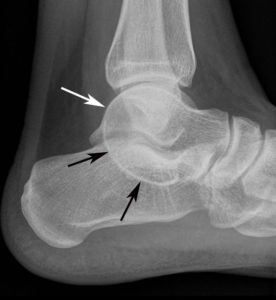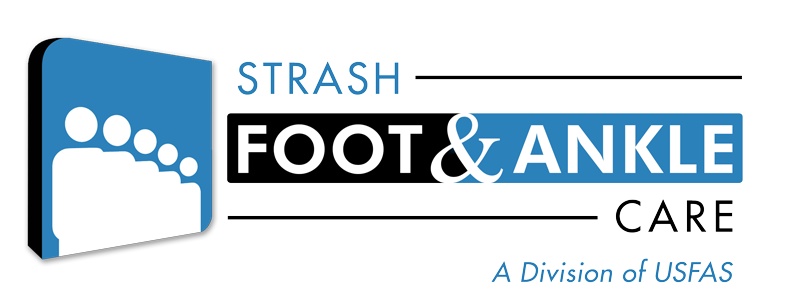19 Mar Tarsal Coalition
A tarsal coalition is a bone condition in feet that causes decreased motion or absence of motion in one or more of the joints in the foot. The lack of motion or absence of motion is due to abnormal bone, cartilage or fibrous tissue growth across a joint. When excess bone has grown across a joint there is usually little or no motion in that joint. Cartilage or fibrous tissue growth can restrict motion of the affected joint to varying degrees causing pain in the affected joint or in surrounding joints.
Tarsal coalitions can occur outside of a joint as well. This is referred to as a bar. A bar connects two bones that don’t normally touch or have a joint between them. The bar will limit motion in the surrounding joints causing abnormal wear and tear to the joints of the foot. This can lead to early arthritis and pain. The bar itself can be painful as well if it is incomplete, traumatized during walking, sporting activities, or an accident.
In the foot, the bones found at the top of the arch, the heel and below the ankle are referred to as the tarsal bones. A tarsal coalition is an abnormal connection between two of the tarsal bones in the back of the foot or the arch. This abnormal connection between two bones is most commonly an inherited trait and passed down from generation to generation. All coalitions are not inherited though. They can also arise from outside sources such as arthritis, infection, trauma and abnormal bone growth. These outside causes are much less frequent.
Signs and Symptoms
Patients with a painful tarsal coalition commonly describe an aching sensation deep in the foot near the ankle or arch. In many cases, muscle spasms on the outside of the affected leg are present. This a natural reaction of the body as it tries to limit the painful motion occurring in the foot. Patients may notice that the affected foot is not as flexible and appears significantly more flattened when compared to the other foot. This only holds true if only one foot is affected, as it is common for both feet to be affected. All flat-footed people do not have tarsal coalitions though. There are many other causes of flat feet as well.
Symptoms most commonly appear in the teenage or early adult years depending on the location of the coalition. It should be noted that not all tarsal coalitions become symptomatic I see many patients that never knew they had a tarsal coalition until it was seen on X-rays taken for other problems. The onset of symptoms may be delayed later into adulthood as well as the joints become more affected with age.
Diagnosis
Diagnosis of a tarsal coalition can usually be made from symptoms described by the patient to the podiatrist and physical exam findings. X-rays are usually taken and in most cases a CT scan or MRI will confirm the diagnosis and provide valuable information regarding the type of coalition, its location, and how the joints have been affected.

Treatment
There are a variety of methods to treat a tarsal coalition depending on the severity of the condition, the age of the patient, and which joint or bones are effected. Conservative podiatric treatment involves non-surgical options. Conservative treatment is directed toward reducing motion in the affected joint to decrease the pain and muscle spasm. Immobilization in a cast or fracture walker boot can calm down the irritated areas and reduce spasms. Orthotics ( custom shoe inserts) are also commonly used to accomplish this on a long term basis to help prevent recurrence of symptoms. Podiatric physical therapy and anti-inflammatory medication may be utilized as well. Cortisone injections in the affected area may provide relief for an indefinite period of time.
These conservative methods of treatment may or may not provide long-term relief.
If symptoms persist then surgical correction is often a good option for long term relief. The type of surgery will depend on the type of coalition, its location, how high or low the arch is and the amount of arthritis and joint damage that has been caused in the foot. If caught early the coalition can be removed to restore motion of the foot. Many times patients do not seek treatment until there has been significant joint damage. In these situations surgery may involve fusing the affected affected joint or surrounding joints. This is designed to limit or completely stop the pain and the painful motion of the affected joints.

